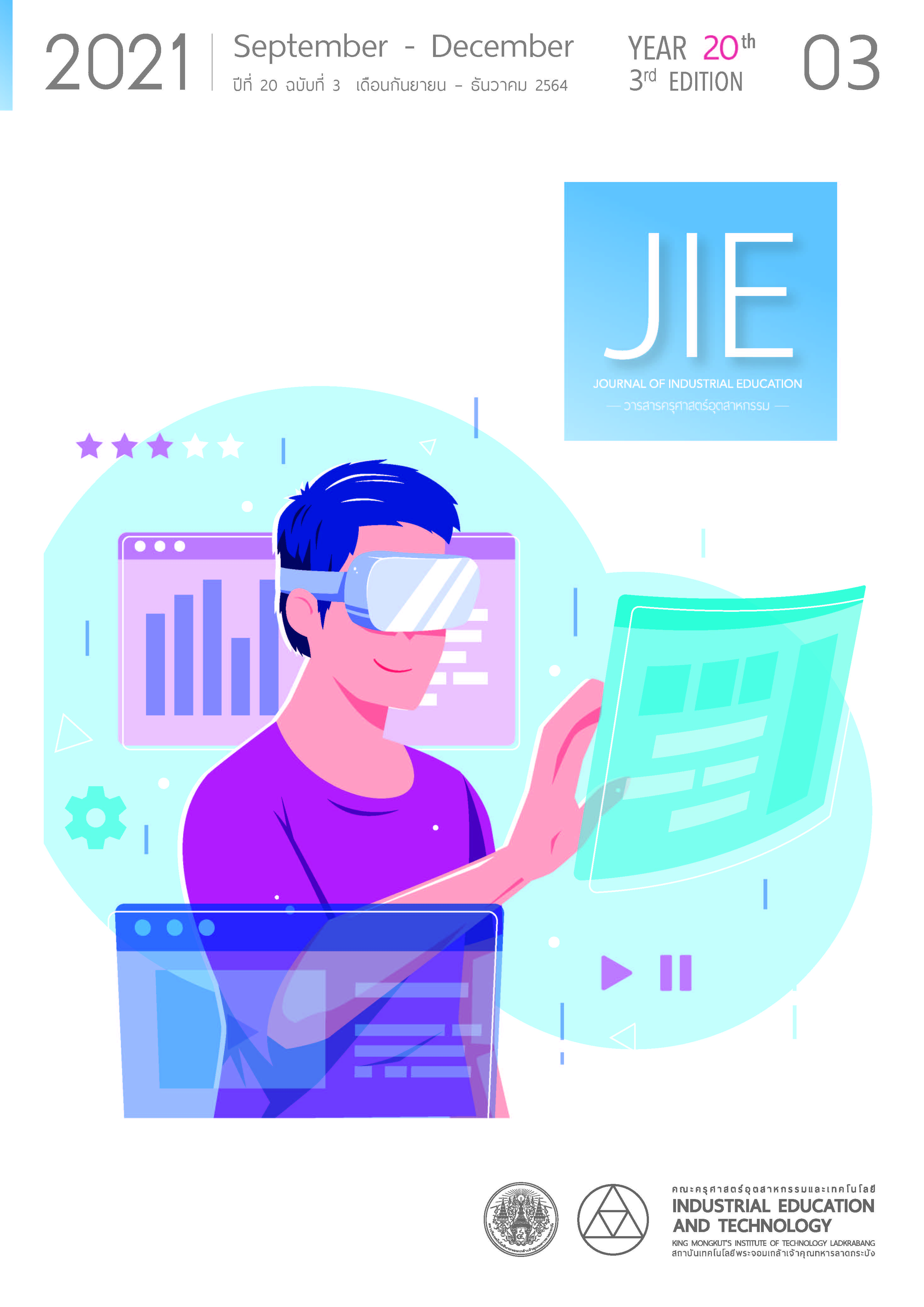การพัฒนาบทเรียนคอมพิวเตอร์ช่วยสอนรายวิชา : คอมพิวเตอร์ช่วยงานเขียนแบบ เรื่อง การใช้คำสั่งในการสร้างภาพ 3 มิติในโปรแกรมโซลิดเวิร์ค
Main Article Content
บทคัดย่อ
การวิจัยครั้งนี้ มีวัตถุประสงค์เพื่อ 1) พัฒนาบทเรียนคอมพิวเตอร์ช่วยสอน รายวิชาคอมพิวเตอร์ช่วยงานเขียนแบบเรื่องการใช้คำสั่งในการสร้างภาพ 3 มิติในโปรแกรมโซลิดเวิร์คให้มีประสิทธิภาพตามเกณฑ์ 80/80 2) ศึกษาผลสัมฤทธิ์ทางการเรียน ของผู้เรียนภายหลังจากที่ได้เรียนรู้ผ่านบทเรียนคอมพิวเตอร์ช่วยสอน รายวิชาคอมพิวเตอร์ช่วยงานเขียนแบบ เรื่อง การใช้คำสั่งในการสร้างภาพ 3 มิติในโปรแกรมโซลิดเวิร์ค และ 3) ศึกษาความพึงพอใจของผู้เรียนภายหลังจากที่ได้เรียนรู้ผ่าน บทเรียนคอมพิวเตอร์ช่วยสอน รายวิชา คอมพิวเตอร์ช่วยงานเขียนแบบ เรื่องการใช้คำสั่งในการสร้างภาพ 3 มิติในโปรแกรมโซลิดเวิร์ค กลุ่มตัวอย่างเป็นนักศึกษาภาควิชาวิศวกรรมเครื่องกล ที่ลงทะเบียนรายวิชา คอมพิวเตอร์ช่วยงานเขียนแบบ ของวิทยาลัยวิศวกรรมศาสตร์ มหาวิทยาลัยรังสิต ภาคเรียนที่ 1 ปีการศึกษา 2563 จำนวน 36 คน โดยการสุ่มแบบเจาะจง เครื่องมือที่ใช้ในการทดลองครั้งนี้คือ 1) บทเรียนคอมพิวเตอร์ช่วยสอน รายวิชา คอมพิวเตอร์ช่วยงานเขียนแบบ เรื่องการใช้คำสั่งในการสร้างภาพ 3 มิติของโปรแกรมโซลิดเวิร์ค 2) แบบทดสอบก่อนเรียน แบบทดสอบหลังเรียนเรื่องการใช้คำสั่งในการสร้างภาพ 3 มิติของโปรแกรม โซลิดเวิร์ค และ 3) แบบสอบถามความพึงพอใจของผู้เรียนที่มีต่อบทเรียนคอมพิวเตอร์ช่วยสอน สถิตที่ใช้ในการวิจัยได้แก่ ค่าเฉลี่ย () ส่วนเบี่ยงเบนมาตรฐาน (S.D.) และการทดสอบค่าที (t-test dependent)
ผลการศึกษาพบว่า ผลการวิจัยพบว่า 1) ประสิทธิภาพของบทเรียนมีค่าเท่ากับ 81.62/86.28 2) ผลสัมฤทธิ์ทางการเรียนของนักศึกษาที่เรียนด้วยบทเรียนคอมพิวเตอร์ช่วยสอน มีผลการเรียนหลังเรียนสูงกว่าก่อนเรียนอย่างมีนัยสำคัญทางสถิติที่ระดับ .05 และ 3) ผู้เรียนมีความพึงพอใจต่อบทเรียนคอมพิวเตอร์ช่วยสอน ในระดับมาก
Article Details

This work is licensed under a Creative Commons Attribution-NonCommercial-NoDerivatives 4.0 International License.
"ข้อคิดเห็น เนื้อหา รวมทั้งการใช้ภาษาในบทความถือเป็นความรับผิดชอบของผู้เขียน"
References
Office of The National Economic and Social Development Council (NESDC). (2012). The twelfth national economic and social development plan (2012-2016). Bangkok: prime minister's office. 2. (in Thai)
The national strategy act B. E. 2560. (2017). The royal gazette. 92nd ed. Bangkok: prime minister's office. 14. (in Thai)
Simmatun, P. (2008). “A development of instructional model using collaborative learning on computer network based learning for undergraduate student based on constructivist theory.” Proceeding of International e-learning conference 2008, Bangkok, Thailand. (in Thai)
Teantong, M. (2001). Courseware design and development for CAI. 2nd ed. Bangkok: King Mongkut's institute of technology north Bangkok textbook publishing center. 12. (in Thai)
Paksaichon, A. (2007). “The Development of Computer Assisted Instruction to Support Studying Biomechanics 1 in Manual Muscle Testing and Range of Motion for the First Year Physical Therapy Students in 2004. ” Journal of Rangsit University: Teaching & Learning. 1(2), 24-35. (in Thai)
Brahmawong, C. (2013). “Developmental testing of media and instructionalpackage.” Silpakorn education research journal. 5(1), 7-20. (in Thai)
Hua, H. T., Liu, Y. C., & Chang, H. C. (2012). “Learning achievement in solving word-based mathematical questions through a computer-assisted learning system.” Educational technology & society. 15(1), 248-259.
Inkart, S. (2009). Introduction to research in educational technology. Bangkok: Ramkhamhaeng University Press. 34. (in Thai)
Sresaard, B. (2017). Basic research. 10th ed. Bangkok: Suviriyasan. 56-68. (in Thai)
Taweerat, P. (1999). Applied behavioral science research. 8th ed. Chulalongkorn University Printing House, Bangkok: Chulalongkorn University. 117. (in Thai)
Sikkabandit, S. (1994). Educational technology. Bangkok: King Mongkut's Institute of Technology North Bangkok. 217–218. (in Thai)
Chainuch, A. (2010). “Web-based tutoring on mobile telephone system at vocational.” Master’s thesis, King Mongkut's Institute of Technology Ladkrabang, 41-44. (in Thai)
Boonpa, S. (2002). “A development of online computer assisted instruction via Internet on principle of programming.” Master’s Thesis, King Mongkut's University of Technology North Bangkok, 45-52. (in Thai)
Sakkavanich, T. (2007). “A development of Interactive e-Learning through the internet in programming course of Ratjapat Chandrakasem University.” Information Technology Journal. 2(5), 43-51. (in Thai)
Yuen, A. H. K. (2006). “Learning to program through interactive simulation.”Educational media international. 43(3), 251-268.
Tanya, N., & Jaturanon, W. (2008). “The development of electronic-online science lessons using high/scope instructional activities for level 3 students at Benjamarachalai school under the Royal Patronage of the King.” Journal of education and social development. 4(2), 77-88. (in Thai)
Erbsree, T. (2005). “The study of math progress with a fundamental practicing module and additional exercises via computer-assisted instruction: a case study of engineering undergraduate students, College of Industrial Technology.” The Journal of Industrial Technology. 1(1), 46-51. (in Thai)

